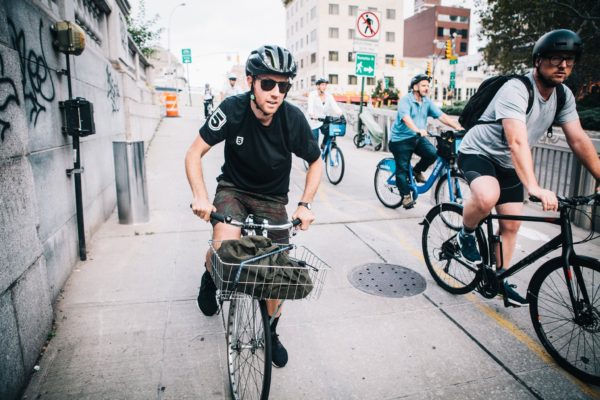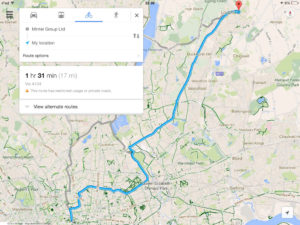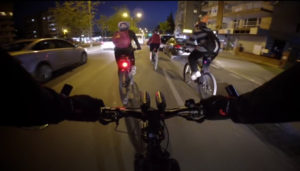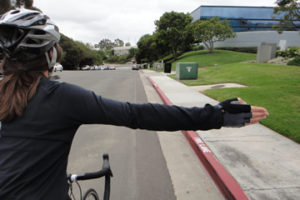You already know that your bike is a tool for good times and fitness, but what about your means of transportation? If you’ve ever been stuck in a traffic jam only to see cyclists whizzing by with a smirk on their face, then you’ve thought about it. Riding to work can seem overwhelming in the beginning. ‘Won’t I get all sweaty? What about my hemet-hair? Where will I keep my bike all day?’ These are all valid concerns, but they don’t stack up as enough to have you hopping in you car everyday. Biking to work (or school, or the coffee shop, or wherever you spend your days) will not only save you money, but it’s way more fun than sitting in your car.
A recent study found that bike commuters are overall happier than their driving counterparts. Whether it be the fresh air, the pumping blood, or the euphoric feeling like you’re a superhero saving the environment, it all adds up to a good time.

Biking to work means you’ll stay fit without much effort, save money on gas or parking fees, decrease your carbon footprint and feel stronger both on and off the bike. Plus, if you get to the office and find a bowl of donuts in the break room, you can go ahead and splurge guilt-free. It also gives you time to prepare for and unwind from the day. You have some buffer time to clear your head before you get to work or arrive back home.
Not convinced? Check out 10 Reasons to Commute to Work on a Bike and we promise to convince you. Once you’re done there, come on back and we’ll go through the things you need to know about getting started biking to work.
1. Map Out Your Route
The route you drive to work may be the best and fastest in a car, but it may not be the best on a bike. The most important element of a good bike commute route is that it is safe. Separation from cars is ideal – the less time you are near them, the safer you will be. You will probably have to ride on a street with cars at some point, but adding a couple miles onto the overall is distance it worth it to stay on roads that are quieter or have a bike path. Good pavement and scenery are bonuses, although a quieter commute should be the main goal.
A bike commute generally goes from a less dense, more residential area to a more dense, more urban area. Both pose challenges. The residential area may have quiet neighborhood streets, but the roads that connect to the urban area may be higher speed roads. The urban area may have more non-driver users, but may also be more crowded. Weigh these aspects when choosing your route.
2. Get the Gear
There’s no need to go out and buy all the gear and a commuter specific bike right off the bat. Depending on the distance of your commute, even a mountain bike can work fine while you get into the habit and see if it’s something you will want to stick with. In plenty of places people will ride in suits, dresses or high heels, so it can be done! However, there are a few pieces of gear that are necessary to get you started.
 Lights and Reflectors
Lights and Reflectors
Your number one concern is to be as visible as you can to cars, especially if you will be commuting at dawn or dusk. So, that means investing in some lights and reflectors for both you and your bike. First things first, you’ll want to have a front-facing white light and a rear facing red light (one solid and one blinking is best). These are legally required in many places, and are a very good idea. Reflectors can be used to supplement bike lights, not replace them.
Helmet
Yes, even if it squishes your carefully done hair, you should always wear a helmet every time you get on your bike. Stash a hair comb, and whatever else you may need for touch ups in your desk at work so you can reverse any helmet damage once you get to the office.
Gear Rack
Let your bike do the heavy lifting for you. A gear rack or panniers are a great way to take the load off your back and keep you comfortable on your commute. Riding with a backpack can be done, but be warned that your back will get sweaty!
Bike Lock
Unless there is a place in your office for your bike to hide away all day, you’re going to need a good bike lock. Always make sure your bike is left in a well-lit, busy area with plenty of pedestrian traffic. You want it to be as difficult to steal as possible.
Fenders
If you’re planning on riding on rainy or muddy days, then fenders are a must. Not only do they keep dirt and grime off you and your cloths, but they also protect your bike and any riders behind you.
3. Stay Safe
Maximize visibility
Assume that you are invisible to motorists. Do whatever you can can to enhance your chances of being seen to avoid accidents. Ride where people and cars see you, wear bright clothing, use lights and reflectors. Whenever possible, make eye contact with drivers and pedestrians to ensure they see you before proceeding through an intersection. The article “Bikes Versus Cars, How to Ride in Traffic” can give more insight into safely riding with traffic.
Stay off the sidewalks
Not only is riding on sidewalks illegal in some places, but it can be dangerous. You run the risk of clipping a pedestrian, or being hit by a vehicle turning or backing out of a driveway that does not see you. Stick to the road and bike lanes where you can.
Pay Attention
It’s up to you to ride defensively. As easy as it can be to space out as you ride through the morning sunshine, you always want to be paying attention to you surroundings. Don’t listen to headphones while you ride, and look out for people that may be opening car doors. Use hand signals whenever you are changing your position on the road to ensure everyone around you knows.
4. Master the Commute
Again, depending on the length of your ride, you will have to figure out a system that works for you. Many people choose to ride in cycling specific clothes and bring a full change of clothes in their bag. If your office doesn’t have a shower, baby wipes can do wonders! Give yourself plenty of time to get to work and lower your heart rate before sitting down at your desk. There’s nothing worse than running into work late, bike in tow and sweat stains all down your shirt. Plus, the more time you have, the more leisurely your ride can be.
Start small and work your way up from there. Ride to work once a week to start, then up it from there. If you miss a day or too if it’s pouring rain or you’re running behind, don’t beat yourself up. Biking to work somedays is better than none!